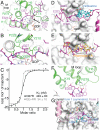Structural convergence for tubulin binding of CPAP and vinca domain microtubule inhibitors
- PMID: 35507869
- PMCID: PMC9171608
- DOI: 10.1073/pnas.2120098119
Structural convergence for tubulin binding of CPAP and vinca domain microtubule inhibitors
Abstract
Microtubule dynamics is regulated by various cellular proteins and perturbed by small-molecule compounds. To what extent the mechanism of the former resembles that of the latter is an open question. We report here structures of tubulin bound to the PN2-3 domain of CPAP, a protein controlling the length of the centrioles. We show that an α-helix of the PN2-3 N-terminal region binds and caps the longitudinal surface of the tubulin β subunit. Moreover, a PN2-3 N-terminal stretch lies in a β-tubulin site also targeted by fungal and bacterial peptide-like inhibitors of the vinca domain, sharing a very similar binding mode with these compounds. Therefore, our results identify several characteristic features of cellular partners that bind to this site and highlight a structural convergence of CPAP with small-molecule inhibitors of microtubule assembly.
Keywords: centrioles; cytoskeleton; microtubule dynamics; peptide inhibitor; structural biology.
Conflict of interest statement
The authors declare no competing interest.
Figures



References
-
- Desai A., Mitchison T. J., Microtubule polymerization dynamics. Annu. Rev. Cell Dev. Biol. 13, 83–117 (1997). - PubMed
-
- Steinmetz M. O., Prota A. E., Microtubule-targeting agents: Strategies to hijack the cytoskeleton. Trends Cell Biol. 28, 776–792 (2018). - PubMed
-
- Amos L. A., What tubulin drugs tell us about microtubule structure and dynamics. Semin. Cell Dev. Biol. 22, 916–926 (2011). - PubMed
Publication types
MeSH terms
Substances
LinkOut - more resources
Full Text Sources
Research Materials
Miscellaneous

